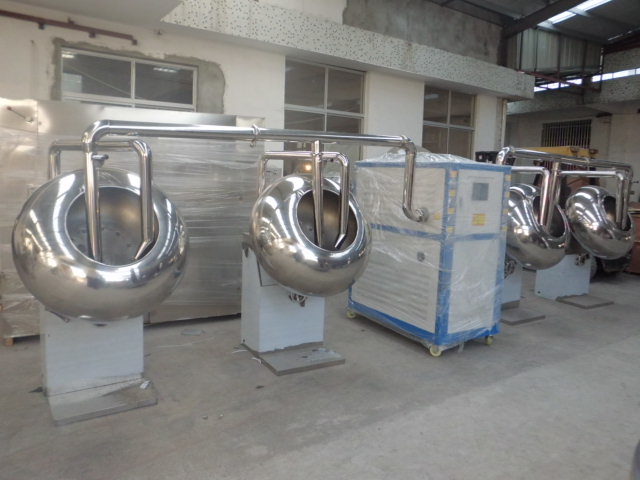The core technology of chocolate candy polishing machinery is based on the synergy of mechanical friction and heat conduction. The equipment uses a rotating polishing barrel or sugar coating pot to make chocolate candies roll up and down under the action of centrifugal force, forming friction with the barrel wall and syrup to achieve uniform distribution of the surface sugar layer. At the same time, the hot air circulation system transfers heat energy to the surface of the candy through the heating pipe, promoting sugar crystallization and forming a smooth and dense solidification coating. This process not only gives chocolate candies an attractive luster, but also effectively isolates air, moisture and odor, extending the shelf life of the product.
In terms of mechanical structure, the polishing barrel is usually made of 304 stainless steel to ensure food safety and corrosion resistance. The inner wall design must take into account both smoothness and friction to avoid candy adhesion or breakage. For example, some equipment installs a scraper on the fixed ring to remove the inner wall residue in real time and maintain the cleanliness of the polishing environment. In addition, the matching design of the conical wheel and the polishing barrel ensures rotation stability and prevents slipping by increasing friction.
The development of chocolate candy polishing technology has experienced an evolution from manual operation to mechanization, automation, and then to intelligence. In the early days, the polishing process relied on manual spraying of syrup and mixing of slurry in batches, which was inefficient and unstable in quality. With the advancement of mechanical technology, the continuously rotating sugar coating pot gradually replaced manual operation, and the motor-driven worm gear achieved low-speed rotation of the pot body, so that the material was polished under the action of centrifugal force.
In recent years, the emergence of fully automatic polishing equipment marks a new breakthrough in industry technology. This type of equipment integrates functions such as automatic loading, coating, unloading, spraying, powdering, dust removal, cleaning, and drying, realizing full-process automated production. The introduction of PLC control systems and remote operation technology has further improved the intelligence level of the equipment. For example, through preset programs, the equipment can automatically adjust parameters such as polishing time, temperature, and speed to ensure the stability of product quality.
In terms of technical details, the fully automatic polishing equipment uses a servo motor to drive the polishing barrel and the inner barrel to rotate at a differential speed, and cooperates with the material distribution plate to achieve the weight and dispersion polishing of the candy. This design not only improves the polishing efficiency, but also can be flexibly adjusted according to the shape and size of the candy to meet diversified production needs.
The application field of chocolate candy polishing machinery and equipment has expanded from single candy production to multiple industries such as pharmaceuticals, food, and chemicals. In the pharmaceutical field, the equipment is used for sugar coating of pills. By adjusting the polishing parameters, sugar coating layers of different thicknesses and glossiness can be achieved to meet special needs such as sustained release and controlled release of drugs.
In the food field, polishing equipment is not only suitable for chocolate candies, but also for rolling, mixing and polishing spherical or granular materials such as peanuts, glutinous rice balls, and pearl powder balls. For example, by adjusting the inclination angle and rotation speed of the polishing barrel, uniform polishing of candies of different shapes can be achieved. In addition, the application of this equipment in the chemical industry is also becoming more and more extensive, such as the production of aluminum hydroxide balls, aluminum oxide balls, ceramic ball molecular sieves, etc., and the surface quality and mechanical strength of the products are improved through polishing.
In specific applications, the performance improvement of polishing equipment is reflected in many aspects. For example, by optimizing the hot air circulation system, the evaporation time of water on the surface of the candy can be significantly shortened, thereby improving production efficiency. By adopting wear-resistant materials and precision processing technology, the service life of the equipment can be extended and maintenance costs can be reduced. By integrating dust removal and cleaning functions, dust pollution in the production process can be reduced and food safety can be ensured.


 中文简体
中文简体 English
English Français
Français عربى
عربى


